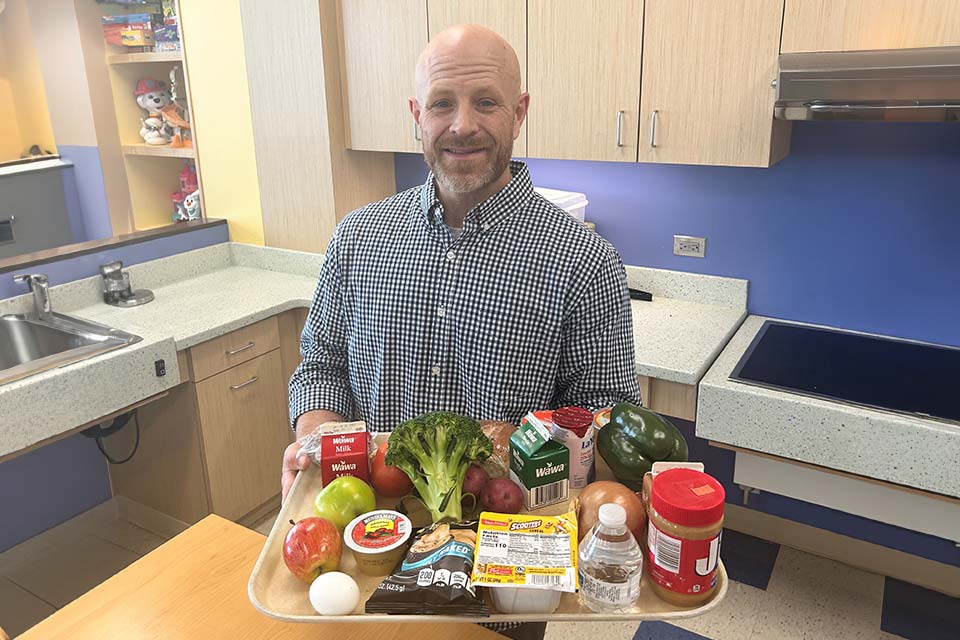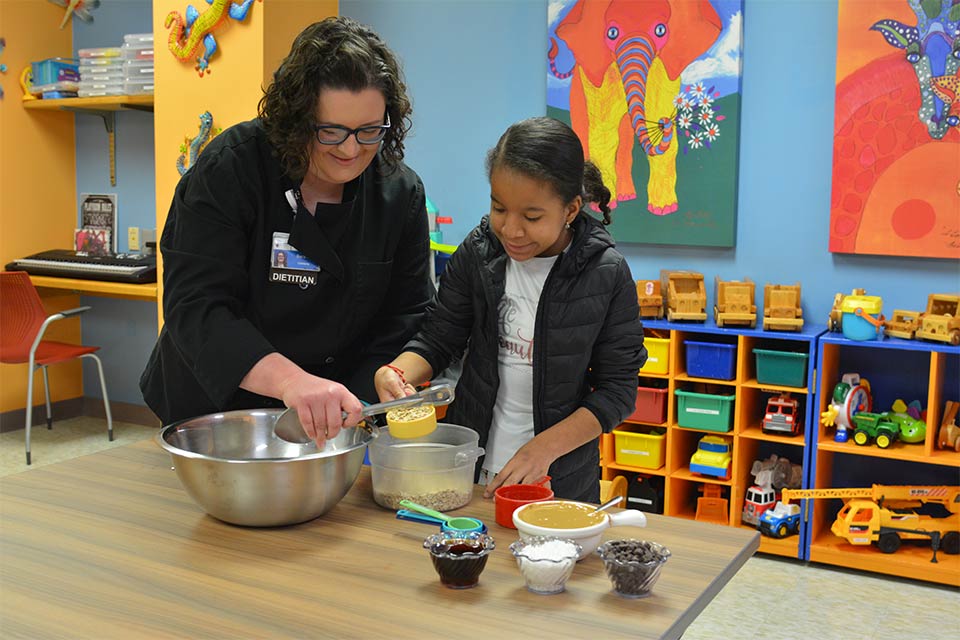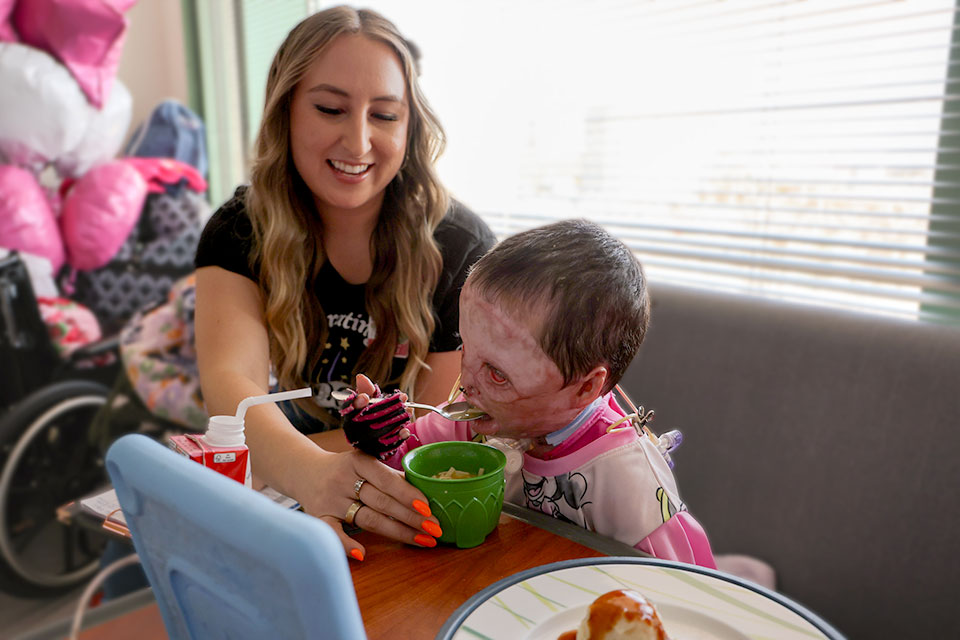From Plate to Progress: The Role of Nutrition in Children's Healing

Mike Szymendera, RD, from Shriners Children's Philadelphia, presents a tray with healthy food options for patients and families.
As March unfolds its vibrant colors, it's not just the blossoming gardens that beckon our attention. This month also marks the celebration of Good Nutrition Month, initiated by the Academy of Nutrition and Dietetics. It's a gentle reminder for us all to pause and consider the significance of making informed food choices and nurturing healthy eating and physical activity habits.
Shriners Children’s comprehensive care model integrates clinical nutritionists and registered dietitians who diligently oversee patients throughout both acute and rehabilitative stages. They extend their expertise nationwide, assisting patients from the sunny shores of Hawaii to the bustling streets of Philadelphia.
“Dietitians are nutrition specialists that serve as an essential part of your child’s interdisciplinary team,” said Sara Ausmus, clinical dietitian at Shriners Children’s Greenville. “They design individualized care plans to ensure your child has balanced nutrition to support postoperative healing, while providing nutrition education to families.”

Sara Ausmus, RD, LD, from Shriners Children's Greenville, teaches a patient how to prepare cookies with healthier ingredient options.
Food Helps Aid All Injuries
Whether it's the thrill of sports, the joy of playground adventures or the simple delight of running freely, children are susceptible to injuries in their active pursuits. With their growth plates still open during development – the most susceptible part of their skeletal system – overuse injuries may occur, stemming from repetitive motions during play. Vital to the healing process is the consumption of proper nutrients, indispensable for facilitating speedy recovery.
“Diet and nutrition play a huge role when it comes to recovering from an injury, even if it’s a sports-related injury,” said Mike Szymendera, registered dietitian at Shriners Children’s Philadelphia. “Good nutrition provides the body with key nutrients for rebuilding injured tissue. Recovery time can be shortened if you are allowing your body to consume the appropriate amount of key nutrients. For example, if an athlete injures a ligament or a tendon, proper nutrition will allow them to recover at a faster rate than an individual who did not focus on proper nutrition.”
“In pediatric sports injury recovery, diet and nutrition are essential for promoting healing, reducing inflammation and supporting muscle recovery,” said Annabelle Toll, registered dietitian at Shriners Children’s Northern California. “As a pediatric dietitian, I emphasize the importance of balanced nutrition, hydration and appropriate energy intake to support children's physical activity and recovery. For example, I may recommend nutrient-rich foods such as lean proteins, whole grains, fruits and vegetables to support tissue repair and provide antioxidants to reduce inflammation. Additionally, we have worked with athletes to ensure they are adequately hydrated before, during and after physical activity to optimize performance and recovery.

Annabelle Toll, RN, from Shriners Children's Northern California, supports a patient receiving treatment for burns.
Nutrition for Burn Patients
At Shriners Children’s burn facilities, registered dietitians are dedicated to ensuring that burn survivors experience healing from the inside out, recognizing that burn injuries can impose one of the most significant nutritional challenges on the body, particularly for children.
“After experiencing a traumatic injury like a life-threatening burn, you become hypermetabolic and your nutritional needs increase,” said Mike. “In some cases, nutritional needs are doubled, and this can become difficult for patients to achieve on a daily basis. Some patients may need a feeding tube to meet their high demanding needs. That is why it is important to work with a registered dietitian to set goals and expectations, and to figure out a plan and strategy to achieve those goals and expectations.”
Hypermetabolism, when the body has a metabolic rate much higher than normal, occurs immediately after a burn injury. Hypermetabolism can be made worse by surgical procedures, pain and anxiety. The larger the burn, the greater the impact. Because of this, it is important to start a nutrition plan within 24-48 hours after a burn injury to prevent entering a hypermetabolic state. This state can last for up to two years after a burn injury and can result in malnutrition.
“A patient with a burn injury will have a significant increase in calorie, protein and fluid requirements to support wound healing,” said Heather Moriyama, manager of nutrition services at Shriners Children’s Hawaii. “Requirements for certain nutrients such as zinc and iron will also need to be increased. If the injury affects the patient’s ability to eat or swallow, a modified consistency diet or tube feeding may be necessary to provide adequate nutrition.”

Jenny Shiel, MS, RN, LDN, (standing), fellow staff member and patient from Shriners Children's Boston, promote Good Nutrition Month.
Why a Good Nutrition Plan Matters
Malnutrition has the potential to negatively affect a child’s recovery, including wound healing, infection rates and length of hospital stay. Children are more vulnerable to malnutrition, as they often have fewer nutritional reserves, are still growing, and require nutrition for growth and healing after an injury.
“After a traumatic injury, patients have a greatly-increased need for calories, protein, vitamins and minerals,” said Jenny Shiel, registered dietitian at Shriners Children’s Boston. “The body especially needs extra protein (choices including eggs, beans, meats and dairy) to heal the areas of injury, and to heal after surgeries. Sometimes these increased needs cannot be met through diet alone, and nutritional support may be needed. Registered dietitians can develop individualized nutritional plans to meet these needs using oral nutritional supplements, enteral or parenteral nutrition.”
For patients recovering from surgery, diet is especially important. According to Sara, after surgery, most children’s appetites are diminished for a few days to a few weeks due to anesthesia, pain and medications that can cause drowsiness, nausea and/or constipation.
“Patients often require light, easy-to-digest meals and snacks for one to three days after surgery, depending on the procedure and if the child experiences any postoperative nausea,” said Sara. “If your child is nauseous, encourage bland meals and snacks, avoiding greasy, spicy and acidic foods to promote tolerance. If your child has a poor appetite, try offering five to six small meals and snacks daily, encouraging protein-rich meats, fish, nuts, legumes and dairy to promote adequate nutrition for healing.”
“Adequate intake of nutrients such as protein, vitamin A, vitamin C and zinc are important for wound healing, tissue repair and immune function after surgery,” said Heather.
“For our rehabilitation patients, all of the above factors apply,” said Annabelle. “This patient population will often have a head injury, stroke or other neurological conditions that affect their swallowing ability. Dysphagia can limit a patient’s ability to eat and drink safely, which can lead to malnutrition if not managed. We work with these patients closely to find things they enjoy eating with the approved texture. Rehab dietitians work very closely to adjust and monitor their enteral nutrition and fluids as they begin to eat more. Some patients will continue to require their enteral nutrition to supplement their food intake, while others will transition off of their enteral nutrition entirely.”
A Fulfilling Career
“One of the best parts of being a registered dietitian at Shriners Children’s is the awesome multidisciplinary care team we get to be a part of every day,” said Jenny. “We participate in daily rounds with other care team members to review patient updates, needs and goals for the day. This sets the tone for the day so that everyone is on the same page, and patients can get the best care possible. By working in both the inpatient and outpatient settings, we can see patients progress throughout their treatment plans, and it is amazing to see them grow and thrive after recovering from major injuries and/or surgeries. Watching patients grow up has been one of the favorite parts of my job!”
Keep In Touch
Join our mailing list to stay up to date on everything that's happening at Shriners Children's.
